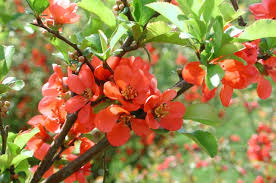
Until we moved to an old house on two patchwork-planted acres, I had never seen a flowering quince. When I first inspected them in June, I was under-whelmed. Each was a thicket of twiggy, green-leafed branches armed with lethal spikes like something out of Br’er Rabbit’s briar patch. Expendable — or so I thought. Then I tried to extract one.
“To pull it out, you need to dig a big enough hole to get a chain around it and hook the chain to a pick-up!” laughs Brent Walston, owner of Evergreen Gardenworks in Kelseyville, CA.
I left the plant, but spent the next two seasons plotting its removal. Then in February, it bloomed. And its virtue dawned. (A lesson in giving plants a full year before deciding to trash or keep them). Dark, elegantly bent, leafless branches were suddenly covered with rose-red buds in a beautiful burst of color, a spirit-lifting contrast to the general monochrome surrounding it.

“The flowers are incredibly beautiful,” notes Gene Sumi, garden horticulturist at Homestead Gardens in Davidsonville, MD. “They are striking in an early spring landscape. That’s when they really shine.”
“The Chinese go crazy for red flowering quince for Chinese New Year,” adds Walston. “Their early spring bloom time coincides with the celebration.”
Their bloom time is not only early, it’s long, another virtue. For several spectacular weeks buds open in leisurely succession, creating an enduring burst of color. Additionally, they force well in water inside. In a vase, three blooming branches look like a Japanese silkscreen –- for weeks.
Though it’s a native of China, flowering quince (Chaenomeles), aka ornamental quince aka japonica has also been cultivated in Japan for centuries and is a favorite plant for bonsai (the painstaking Japanese art of potted miniaturized trees and shrubs). The Dutch introduced flowering quince to Long Island in the late 17th century and by the 18th century, it was popular for hedging in New England due to both its hardiness and its prickly ability to keep out unwanted livestock.
Despite the name, flowering quince is not the same plant as the quince fruit tree (Cydonia sinensis), which is not hardy in Maryland. However, the shrubby flowering quince does produce small, rock-hard fruits (though mine never have; they’re in too much shade) that Europeans use to make a tart jam and that the Chinese use medicinally for liver and spleen complaints and to promote blood circulation.
TYPES

While they can also be useful for erosion control and prowler prevention if planted beneath windows, the primary pleasure of flowering quinces are their beautiful, apple-blossom like flowers. (The double-flowered varieties look like camellia blooms).
“Some blooms are pastel shades,” says Sumi. “Others are very bright. There is one called ‘Crimson and Gold’ that has a brilliant red flower with showy yellow anthers.”
Colors range from white `Nivalis’ to the bright red profusion of ‘Texas Scarlet’ and dark red of ‘Simonii’ to orange with shades and hues in between. ‘Rosea Plena’ is pale rose pink. ‘Apple Blossom’ has white flowers that turn pink with age. ‘Falconet Charlotte’ has deep pink flowers and ‘Cameo’ is a rich salmon. Each bloom of ‘Toyo Nishiki,’ is a combination of pink, white and red.

While many flowering quinces range from 4-10 feet in height, there are also prostrate varieties, like ‘Jet Trail’, with pure white flowers and ‘Iwai Nishiki’ whose dark red blooms tend to form clusters sometimes six inches across. Small, contorted varieties, whose stems are exaggeratedly twisted and gnarled, are nice for landscaping but are particularly good for bonsai. ‘Hime,’ with solid red flowers and showy yellow stamens is a favorite, as is ‘Kan Toyo,’ whose pink flowers are only about 1/2 inch across. ‘Red Contorted’ has solid red buds that open to a deep pink.

CULTURE
Cold-hardy and drought-resistant, flowering quince thrives in almost any soil. They like full sun, though they must be protected from midday-sun in excessive heat, and will bloom, though less effusively, in light shade. Their big drawback is their vigorous growth habit.
“They can get quite large if left unchecked,” warns Walston. “Some of big ones like ‘Toyo Nishiki’ can get to be 10-15 feet tall if you don’t prune.”
Pruning regularly, either during or immediately after blooming, will keep a flowering quince civilized. For least maintenance, Walston recommends buying semi-dwarf and dwarf varieties like ‘Orange Delight,’ which gets only four feet tall.
“They’re the best for most landscapes since they won’t get out of hand and you don’t have to prune to keep them in line,” he says.
SOURCES:
Homestead Gardens
743 W. Central Ave.
Davidsonville, MD
301-261-4550
410-798-5000
410-956-4777
Evergreen Gardenworks
P.O. Box 537
Kelseyville, CA 95451
email: bonsai@pacific.net
Gerry’s Tree and Shrub Nursery
Gerry Holwell
PO Box 311
Twillingate, Newfoundland
A0G 1Y0 Telephone:
(709) 884-2052
email: gerryandmaisie@personainternet.com
Portland Nursery
5050 SE Stark
Portland, OR 97215
503-231-5050
This article was first published in The Baltimore Sun in 2011.